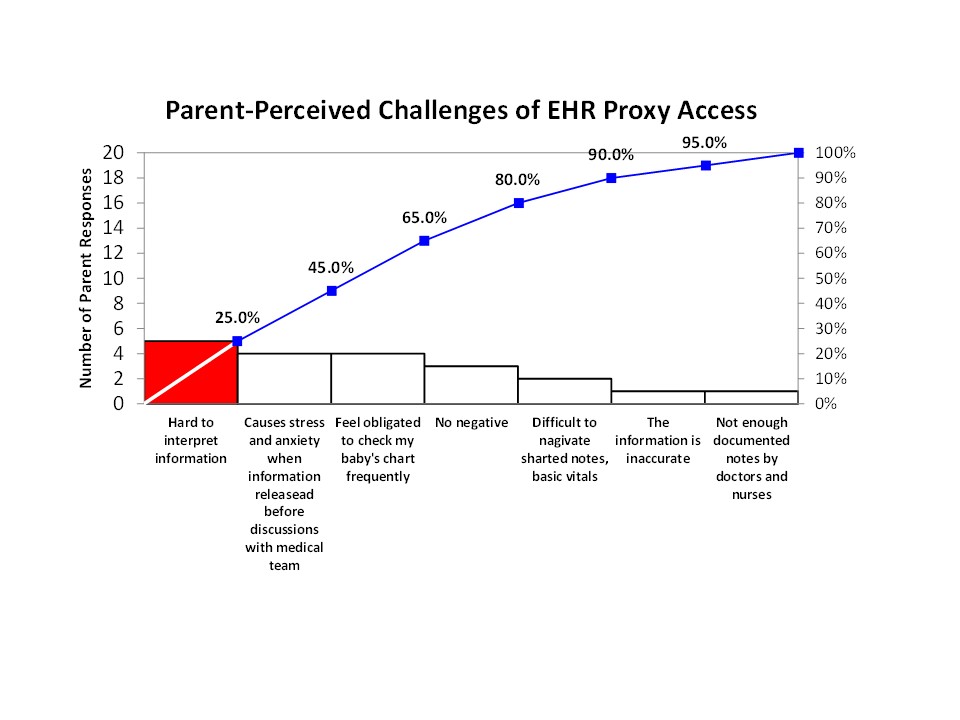Back
Neonatal Quality Improvement
Category: Abstract Submission
Neonatal Quality Improvement V
390 - Improving Parental Experience of Electronic Patient Portal Proxy Access at a Level IV NICU: A Quality Improvement Initiative
Monday, April 25, 2022
3:30 PM – 6:00 PM US MT
Poster Number: 390
Publication Number: 390.435
Publication Number: 390.435
Leslie M. Harris, Yale School of Medicine, New Haven, CT, United States; Victoria Tallberg, Yale-New Haven Children's Hospital, STRATFORD, CT, United States; Elizabeth G. Crespo, Yale-New Haven Children's Hospital, Cheshire, CT, United States; Kelly Kline, Yale New Haven Hospital, East Haven, CT, United States; Michelle Gray, Yale-New Haven Children's Hospital, New Haven, CT, United States; Tracy Gambardella, Yale-New Haven Children's Hospital, Branford, CT, United States; Melissa Olinger, Yale-New Haven Children's Hospital, New Haven, CT, United States; Kelli Garrington, Yale New Haven Hospital, New Haven, CT, United States; Lindsey Garcia, Yale-New Haven Children's Hospital, New Haven, CT, United States; Noa Fleiss, Yale School of Medicine, New Haven, CT, United States

Leslie M. Harris, MD (she/her/hers)
Neonatal-Perinatal Medicine Fellow
Yale-New Haven Children's Hospital
New Haven, Connecticut, United States
Presenting Author(s)
Background: Recently, the 21st Century Cures Act took effect mandating increased direct-to-patient reporting of test results and clinical documentation. This resulted in dramatic practice changes, particularly in the inpatient setting where dynamic aspects of clinical management are being shared with patients in real time. There is no clear guidance for medical providers on how to navigate patient portal access to the electronic health record (EHR). Critically ill infants’ EHR and proxy access by parents/caregivers are of special concern, yet very little is known about what information parents of infants in the neonatal ICU (NICU) access. Even less is known about how this information affects parental understanding, stress, and satisfaction of care for their infant.
Objective: To establish a quality improvement (QI) initiative in the neonatal ICU that increases parental proxy access to infants’ EHR and improves their proxy experience while reducing associated stress.
Design/Methods: All patients admitted to the level IV NICU were included from 5/1/21-12/17/21. Using the Institute for Healthcare Improvement’s (IHI) Model for Improvement, we implemented process-based interventions targeting stressors and obstacles associated with parental proxy access. A web-based survey was used to assess parent experience and a Pareto chart was created based on responses.
Results: Approximately 77% of infants have an active proxy with access to their EHR portal. Figure 1 shows weekly proxy access at the time of NICU discharge over the past six months, annotating timing of QI team establishment and timing of the first two PDSA cycles. Thus far, there has been no significant shift in our mean of parental proxy access. 29 parents responded to the experience survey and rated overall satisfaction with proxy access as good to excellent. Parents report enjoying access to test results and provider notes, feeling involved and informed about their infant’s care, and not having to wait for information. As shown in Figure 2, parents report dissatisfaction with feeling obligated to check the EHR portal frequently and the stress and anxiety caused by receiving information before speaking with the medical team.Conclusion(s): We established a NICU-based QI initiative focused on proxy access, provider communication, and parents’ experience of the electronic patient portal. These initial data will inform future interventions to further target challenges such as hard to interpret information, language disparities, and additional parent stress related to early access to results.
Leslie M Harris Curriculum VitaeLeslie M Harris CV January 2022 .pdf
Figure 2. Pareto Chart of Parent-Perceived Challenges of EHR Proxy Access
Objective: To establish a quality improvement (QI) initiative in the neonatal ICU that increases parental proxy access to infants’ EHR and improves their proxy experience while reducing associated stress.
Design/Methods: All patients admitted to the level IV NICU were included from 5/1/21-12/17/21. Using the Institute for Healthcare Improvement’s (IHI) Model for Improvement, we implemented process-based interventions targeting stressors and obstacles associated with parental proxy access. A web-based survey was used to assess parent experience and a Pareto chart was created based on responses.
Results: Approximately 77% of infants have an active proxy with access to their EHR portal. Figure 1 shows weekly proxy access at the time of NICU discharge over the past six months, annotating timing of QI team establishment and timing of the first two PDSA cycles. Thus far, there has been no significant shift in our mean of parental proxy access. 29 parents responded to the experience survey and rated overall satisfaction with proxy access as good to excellent. Parents report enjoying access to test results and provider notes, feeling involved and informed about their infant’s care, and not having to wait for information. As shown in Figure 2, parents report dissatisfaction with feeling obligated to check the EHR portal frequently and the stress and anxiety caused by receiving information before speaking with the medical team.Conclusion(s): We established a NICU-based QI initiative focused on proxy access, provider communication, and parents’ experience of the electronic patient portal. These initial data will inform future interventions to further target challenges such as hard to interpret information, language disparities, and additional parent stress related to early access to results.
Leslie M Harris Curriculum VitaeLeslie M Harris CV January 2022 .pdf
Figure 2. Pareto Chart of Parent-Perceived Challenges of EHR Proxy Access

